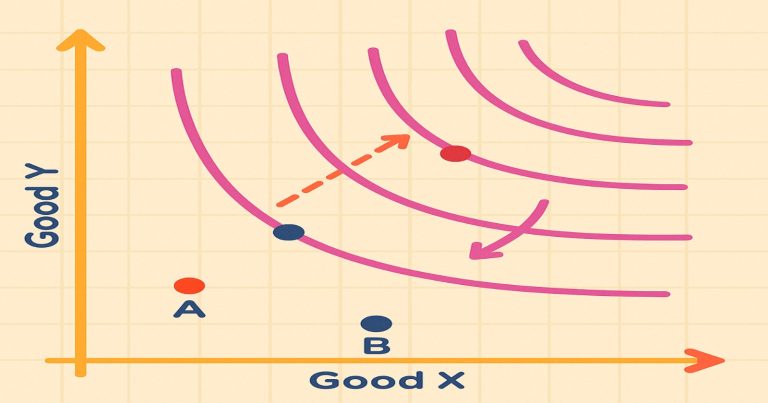Features of the Indifference Curve are crucial in understanding consumer preferences in economics. An indifference curve represents a graphical depiction of different combinations of two goods that give a consumer the same level of satisfaction or utility. These curves are central to microeconomic theory as they illustrate consumer choices, helping to explain how consumers allocate their income across various goods and services. By analyzing the features of indifference curves, economists gain insights into consumer behavior, the trade-offs consumers face, and how they respond to changes in prices and income.
What is an Indifference Curve?
An Indifference Curve is a curve that represents all combinations of two goods that provide a consumer with the same level of satisfaction or utility. Each point on the curve shows a different combination of the two goods, but since all combinations provide equal utility, the consumer has no preference for one over the other. The indifference curve is typically downward sloping, reflecting the trade-off between the two goods; as the quantity of one good increases, the quantity of the other must decrease to maintain the same level of satisfaction.
Key Characteristics of Indifference Curves:
- Downward Sloping: Indifference curves slope downward from left to right, showing that as one good is substituted for another, the total utility remains constant.
- Convex to the Origin: The curve is typically convex to the origin, reflecting diminishing marginal rates of substitution between the two goods.
- Non-Intersecting: Indifference curves cannot intersect because each curve represents a different level of utility, and two different levels of utility cannot be equal at the same time.
Indifference curves provide an essential tool for analyzing consumer behavior, enabling economists to model how consumers make choices between two goods based on their preferences, income, and the prices of goods.
Downward Sloping Feature of Indifference Curves
One of the most fundamental features of indifference curve is its downward slope. This characteristic reflects the trade-off that a consumer faces when choosing between two goods. Specifically, the curve slopes downward from left to right, indicating that if the quantity of one good increases, the quantity of the other must decrease to maintain the same level of satisfaction.
Why is the Curve Downward Sloping?
- Substitution Effect: As a consumer has more of one good, they are willing to sacrifice some amount of the other good to maintain the same utility. For example, if a person has plenty of apples, they might be willing to give up some apples in exchange for more oranges, maintaining the same level of satisfaction.
- Diminishing Marginal Utility: The principle of diminishing marginal utility suggests that as the consumer increases the consumption of one good, the additional satisfaction derived from consuming more of that good decreases. Therefore, to maintain overall satisfaction, they must reduce consumption of the other goods.
Economic Implications
- This downward slope helps explain consumer behavior in terms of how individuals make trade-offs between goods. For example, if the price of one good falls, consumers may increase consumption of that good while decreasing consumption of the other, maintaining their level of satisfaction.
Convexity of Indifference Curves
Another critical feature of indifference curve is its convexity to the origin. This means that the curve is bowed inward, with the slope becoming flatter as you move along the curve. The convex shape indicates that as a consumer has more of one good, they are willing to give up fewer units of the other good to maintain the same level of satisfaction.
Why Are Indifference Curves Convex?
- Diminishing Marginal Rate of Substitution (MRS): The concept of diminishing marginal rate of substitution explains convexity. The MRS refers to the rate at which a consumer is willing to trade one good for another. As a consumer substitutes one good for another, they require less and less of the second good to compensate for giving up units of the first good.
- Real-World Relevance: In real life, people are generally more willing to give up a good when they have a lot of it (such as food or clothing) and are less willing to sacrifice a good when they already have little of it.
Economic Implications
- Convex indifference curves reflect real consumer behavior, where consumers prefer balanced consumption of goods rather than extremes. This feature helps model how consumers adjust their consumption in response to changes in prices and income.
Non-Intersecting Nature of Indifference Curves
A significant feature of indifference curve is that they do not intersect with each other. This characteristic is crucial in maintaining consistency in consumer preferences. If two indifference curves were to intersect, it would imply that the consumer could simultaneously achieve two different levels of utility at the same combination of goods, which is logically inconsistent.
Why Don’t Indifference Curves Intersect?
- Consistency of Preferences: The principle of transitivity in consumer preferences states that if a consumer prefers A to B and B to C, then they must prefer A to C. If indifference curves intersect, it would violate this principle by creating contradictory preferences at the intersection point.
- Distinct Levels of Utility: Each indifference curve represents a different level of utility. If curves intersected, it would imply that two different levels of utility were equivalent, which is not possible.
Economic Implications
- This feature of indifference curves ensures that each curve is associated with a distinct level of utility, and it helps maintain the integrity of consumer choice theory. It also simplifies the analysis of optimal consumption, as each point on a specific curve represents an equally preferred bundle of goods.
Higher Indifference Curves Represent Higher Utility
One of the intuitive features of indifference curve is that curves that are positioned farther from the origin represent higher levels of utility. This means that a consumer prefers bundles of goods represented by higher indifference curves over those represented by lower curves, all else being equal.
Why Do Higher Curves Represent More Utility?
- More of Both Goods: Higher curves reflect combinations of goods where the consumer has more of both goods, increasing their overall satisfaction.
- Utility Maximization: Consumers aim to reach the highest indifference curve possible within their budget constraints to maximize their utility. The farther the curve is from the origin, the more utility it represents.
Economic Implications
- The concept of higher indifference curves representing higher utility is crucial for understanding consumer choice. It helps explain how consumers make decisions about their consumption bundles when faced with income limitations or price changes.
Indifference Curves Are Based on Consumer Preferences
The features of indifference curve are based on subjective consumer preferences. These curves reflect the individual’s unique tastes and preferences for the goods they consume. Since preferences vary from person to person, each consumer will have a different set of indifference curves based on their utility for different combinations of goods.
Why Are Indifference Curves Subjective?
- Personal Preferences: Different individuals value goods differently. For example, one person may prefer more leisure time while another values more goods or services. Therefore, each consumer’s indifference curves will be different.
- Heterogeneous Choices: The diversity of consumer choices in the economy is represented through different sets of indifference curves, each reflecting different levels of satisfaction and trade-offs between goods.
Economic Implications
- The subjective nature of indifference curves emphasizes the importance of personal preferences in consumer choice theory. It also highlights that there is no universal standard for utility, as different people derive satisfaction from different goods.
Conclusion
The features of indifference curves are essential in understanding consumer behavior and preferences. These curves help economists and policymakers analyze how consumers make choices and allocate their income among different goods. Key features, such as downward slope, convexity, non-intersection, and preference-based rankings, allow for a deeper understanding of economic trade-offs and utility maximization. While these features help model individual consumption patterns, they also provide valuable insights into the broader economy’s demand for goods and services, influencing market trends and policy decisions.
Features of Indifference Curve FAQs
What are Indifference Curves?
Indifference Curves represent different combinations of two goods that give a consumer the same level of satisfaction or utility.
Why are Indifference Curves downward sloping?
Indifference Curves are downward sloping because as the quantity of one good increases, the consumer must decrease the amount of the other good to maintain the same level of satisfaction.
What does the convexity of an Indifference Curve mean?
The convex shape of an Indifference Curve reflects diminishing marginal rates of substitution, meaning as a consumer has more of one good, they are less willing to give up the other good to maintain the same level of satisfaction.
Why don’t Indifference Curves intersect?
Indifference Curves do not intersect because each curve represents a different level of utility, and two different levels of utility cannot be equivalent at the same combination of goods.
What do higher Indifference Curves represent?
Higher Indifference Curves represent combinations of goods that provide higher levels of utility, indicating greater satisfaction to the consumer.


